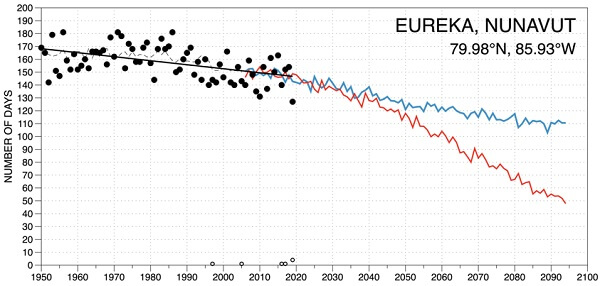
Arctic Awesome: The Story of the ‘Cool’ Students of ‘Not Cool’
– By Halah Mhanni, Safia Soussi and Amy Mann –
It is well known that the Arctic is warming around twice the global average, three times the global average in Canada. This substantial rate of warming has given rise to a lot of much-needed research into its changing climate over the past decade. That said, this research has overwhelmingly focused on the gain of heat – global warming – rather than the loss of cold. Given the importance of cold weather to the region’s cryosphere, economy, and culture, we felt this was worth examining. In our research, we focused on the loss of cold in 34 specific weather stations above 60 degrees latitude from each of the three territories.
The main objective of our research was to iterate the importance of an Arctic-centric approach when delving into climate change in the north. The cold is an integral part of the Arctic, it sustains the ecosystem and the people as well. Our objectives were to present observed data, as well as projections for the number of cold days. In our research, we focused on 34 specific weather stations above 60 degrees latitude from each of the three territories. Near the northernmost tip of Canada, in Nunavut, stands a weather station named Eureka that began collecting data in the early to the mid-20th century. Eureka is the coldest area in Canada above the 60-degree latitude and during its coldest month averages, a minimum temperature of -37.4 degrees Celsius, and during its warmer months average of 6.1 degrees celsius. In comparison with Winnipeg, which averages a temperature of -16.4 degrees Celsius during its coldest month and 19.7 degrees celsius in its warmest. Between the years 1950 to 2020 a steady decrease in the number of cold days (characterized as a day with an average temperature of -30 degrees celsius), with approximately -3.13 days/decade lost. It should be mentioned that in our research, we considered a climate year as beginning in September and ending in August of the next calendar year.

Using RCP data, we were able to give an approximate trajectory to the future of Eureka in terms of cold days. In the RCP 8.5 scenario (high-carbon or ‘Business as usual’) by the year 2090, Eureka would experience approximately 55 cold days in stark contrast with the 180 cold days in 1955. In the RCP 4.5 scenario (low-carbon) by the year 2090, Eureka would experience 110 cold days.
In October of 2019, our grade 10 geography teacher, Ms. Jennifer Janzen, proposed to our class an opportunity to work with a professor at the University of Winnipeg. Multiple students signed up, and within the next few weeks, we were invited to meet with Professor Danny Blair in the Geography department. It was in that meeting that Professor Blair suggested the idea to look at global warming from a different lens, an arctic-centric point of view, seeing climate change less as the gain of heat, but as the loss of cold. This idea intrigued us and allowed us to move forward with the project. Within the next month, we met once again with Professor Blair where we were instructed on what our next steps would be, each of us first picking a territory to research, Halah with Yukon, Safia with North-West Territories and finally Amy with Nunavut. Via the prairie climate center with the help of Mathew Loxley, we received data and sorted through the stations, finding the stations with the longest recorded times. We created our graphs and decided on which stations held enough data to be able to accurately depict our findings. Then, it was finally time to put our findings into writing, for months, Professor Blair instructed us on ways to improve our academic writing and after a lengthy editing period, we came up with our final draft that was submitted, edited again, and finally published in April 2021.
As high schoolers, the prospect of writing an academic paper that could be read by professionals was quite daunting. However, with the support of Ms. Janzen and Professor Blair, we were able to gain confidence and move forward with this project. Watching the entire idea unfold from a single idea Professor Blair had in 2019 to what it has become today in 2022 is amazing, and has shown to us the excitement and importance of research. Although it was not easy, and we were faced with many obstacles along the way, we were still able to accomplish our initial objective, the analysis of climate change with an Arctic-centric approach, in other words, the loss of cold.
The Arctic has been warming at an alarming rate, causing massive ripple effects throughout the region, as well as worldwide. As the younger generation, our priority lies in creating a better, more sustainable future for ourselves, and those that come after us. In doing this research, we were able to truly understand the changing climate from a different perspective, an arctic-centric perspective. Working for over a year on a project that we hold so dear to our hearts has been an amazing experience, and one we will not soon forget.
Mhanni, Soussi and Man discovered their interest in arctic issues during their Geography class in grade ten. After being offered the opportunity to work with a geography professor, they became first time published authors at the age of 16-17. They have now since graduated from the University of Winnipeg Collegiate and attend their respective universities.
